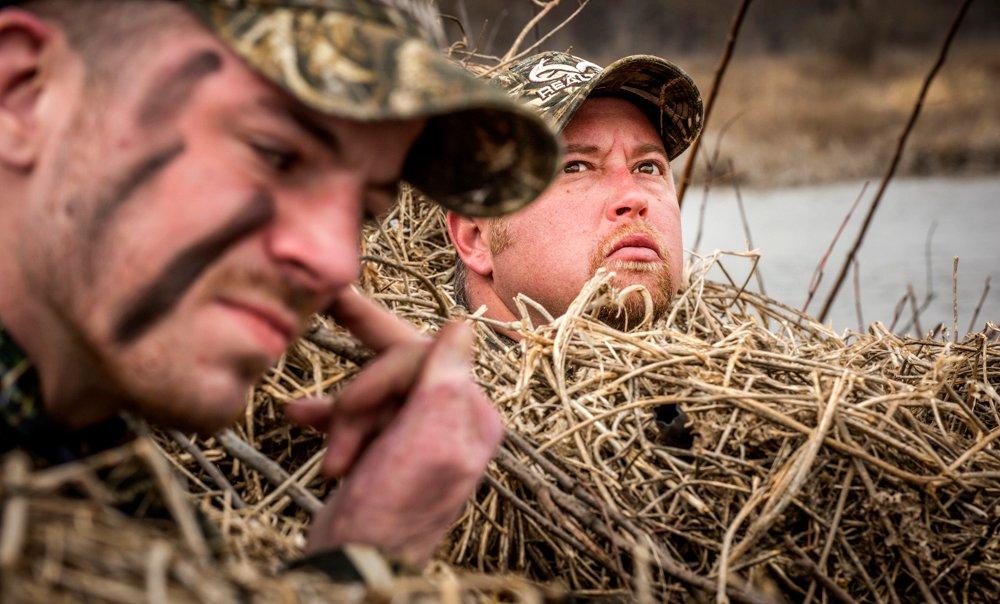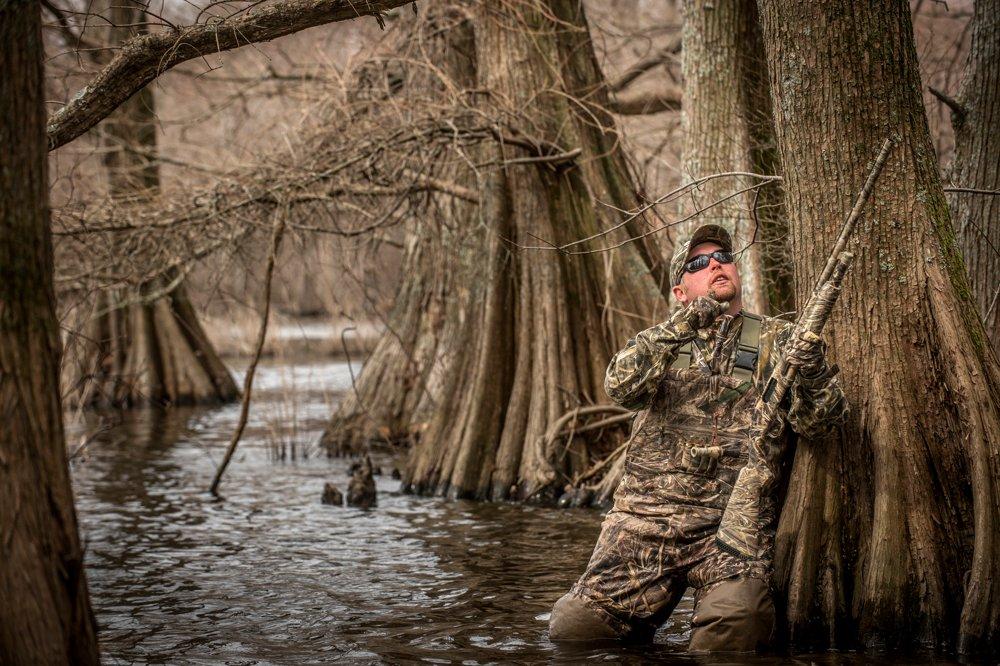These common mistakes ruin many duck hunts, so avoid them at all costs
An old saying holds that life is tough, but it's tougher if you're stupid. Duck hunters might interpret that to mean waterfowling is inherently difficult, but becomes much tougher if you make silly mistakes.
Think about it. Waterfowlers already deal with multiple variables such as weather, other hunters, and the fickle nature of migration. Committing errors — even seemingly small gaffes — further stacks the odds against you.
Recognizing potential mistakes is critical if you hope to avoid them. Just ask today's top duck pros, many of whom have guided hunters throughout the flyways and witnessed many foul-ups that doomed otherwise promising hunts. Here's their hit list of the top mistakes duck hunters commit — and tips on how to fix them.
Not Hiding Well Enough
This entry won't surprise anyone. Whether you're hunting timber, water, or fields, you must be concealed from the sharp eyes of waterfowl. Otherwise, you won't shoot many birds. Still, some folks make this blunder again and again.
I think the biggest mistake hunters make in general is not being hidden well enough, said Tony Vandemore, owner of Habitat Flats near Sumner, Missouri. "Cover up, whether it's with natural or manmade materials. When you think you have enough cover, you're probably halfway there."
Be still, and avoid the temptation to look up as birds pass overhead.
You can't just have your face out looking at ducks, said Chad Belding, host of The Fowl Life. Wear a facemask. Hunters don't wear facemasks enough.
(Don't miss: Our 20 Best Tips for Hunting Diving Ducks)
Trucks Parked Too Close
Likewise, many hunters make another seemingly duh blunder when trying to hide in harvested agricultural fields. The biggest mistake I see field hunters make is parking their vehicles, said veteran guide Cooper Olmstead of Habitat Flats. Time and time again, I see trucks and trailers parked a couple of hundred yards from the spread. Don't let your hunt be ruined because you're being lazy.
Olmstead said hunters should park vehicles sufficiently far away and under cover, if possible. Further, consider the approach routes of birds. You don't want them flying directly over your vehicles or having to land into your spread and see them in the background, he said.
Rusty Shotgunning Skills
Jordan Clark of Dog 'N' Duck Outfitters near Viking, Alberta, guides dozens of hunters per season — many of whom haven't sufficiently sharpened their shooting skills.
From a guide's perspective, some guys are changing chokes and shot sizes, and they don't have enough shooting practice for different scenarios and flight paths.
The fix is simple. Shoot more during the off-season. It's fun, and the reps will help you put more ducks on the strap.
Fear of Change
Belding said many dry-field hunters seem hesitant to hit pause during a hunt and change their setup, even if birds aren't reacting well.
They think the next flock will do it, he said. Hunters usually are afraid to make changes to their spread after they see the ducks are not working. They just settle for that and try to shoot them over to the right or left, where the guys on the other side don't have a chance because they can't get their guns pointed over there.
Watch the first flock or two to see how birds react to a setup, Belding said. If ducks don't commit, switch things up. Take the time to get out and make changes as soon as you see that first or second flock commit, and let their body language tell you what the decoy spread, your calling, the blind, or your blind placement or concealment is telling the flock of ducks, he said.
That also goes for spinners, which are a staple of field duck hunts.
We use up to four or five spinners at a time," said Belding, "but if you don't have them placed right and you see those ducks get way upwind of you or go downwind and stop short of you, it might be because you're not finishing them with those spinning wings. Don't be afraid to get out and move those spinning wings around. You might also have full-body goose decoys or full-body duck decoys out. Don't be afraid to change up the shape of your decoy spread. Then jump back in the blind and see what happens.
No Room
Clark said many hunters commit a cardinal sin when arranging spreads on lakes or marshes.
For water shoots, a lot of duck hunters make the mistake of not making adequate landing pockets for the ducks in their decoy spread, he said. You want to treat the water like land and have a good pocket for them to commit to the spread.
Critique your decoys before the action starts. If your kill hole looks too small, open things up.
Too Much Noise
Olmstead pointed out another common open-water blunder: overcalling. Hunters love seeing birds react to calling, but more usually isn't better. It can be your biggest downfall, he said. Time and time again, hunters overcall birds and blow them out of the spread. My biggest tip would be to change up your calling. Watch the birds and see what they react to. Just because you have a call doesn't mean you have to use it to its fullest or use it at all.
"Some of the biggest mistakes I've seen are people hunting the same way day in and day out and complaining there are no birds."
A Dead Spread
Many water hunters don't focus enough on adding movement to their decoy spread, especially during calm days. That's a huge mistake that ducks immediately recognize as being unnatural.
You have to remember that ducks are always moving, Belding said. They're scurrying up the sediment, and they're kicking up their feet. Even when they are sleeping, they're still kicking their feet some.
Ducks passing over a decoy spread instinctively expect to see movement — or at least muddied water from duck activity. Belding recommends using a jerk string or mechanical decoys that add motion to a spread. Spinning-wing decoys can also help, but he said hunters should avoid setting them right in the kill hole.
They want to see action and movement, and a realistic decoy spread tells them, hey, those ducks are moving around, he said. They're feeding and active, and they're down there for a reason. You're going to have an easier time getting flocks of ducks to commit by making sure your decoys and the water look realistic.
(Don't miss: Our 30 Best Mallard Hunting Tips)
Too Hidden in the Timber
Decoy visibility is a big factor during green-timber hunts, but Olmstead said some hunters don't pay enough attention to that. One of the bigger mistakes I see in timber is not making yourself visible from all directions, he said. You want to make sure that the ducks can see you from any direction they are traveling or flying over you. Play the wind with the majority of your spread and spinners, but don't be afraid to put some decoys and spinners across the hole or off to the sides — anything to make yourself visible from every angle.
Not Working the Shadows
Belding said many timber hunters also commit another mistake: not adapting their concealment strategy to the weather conditions.
I think the biggest mistake duck hunters make in flooded timber is not understanding the difference between sunny days and days that are not sunny, he said. When it's sunny, you can get away with a lot more. You stand on the dark side of the tree. You can kind of time the ducks, where you can move out into the sun when they are not looking at you and are going away, and then you hit them with that call, and they spin, and then you get back to the dark side of the tree when they are over the top of your canopy or decoy hole. You just use that dark side to hide from them.
That doesn't work during cloudy or overcast conditions.
You can't get away with as much, Belding said. They will pick you apart a lot easier on those non-sunny days. You have to stay closer to the tree, and you might even have to move back a couple of rows and not be right on top of the hole, because they can see a lot better when there's not sunshine down in those holes and canopies. And when you're kicking the water, or making those sounds while you're slapping your thigh, make sure you're timing it out well so you're not bringing attention to where the hunters are.
Not Facing a New Day
Some of the biggest mistakes I've seen are people hunting the same way day in and day out and complaining there are no birds, said Jeremy Dersham, owner of Ridge and River Running Outfitters in southern Wisconsin. The reality is each year, each day, and each species are different.
Dersham always considers the situation and phase of the migration when setting up. During the early season for local wood ducks, he often uses just two to six decoys and one or two spinners and enjoys great success.
On the other hand, a week or two later, I'm on the big water, and the migration is in full effect, he said. Then I'm using 100 to 150 decoys with a smorgasbord of duck species and concentrating on birds going from roosts to loafing areas. My main objective is to change my approach to the conditions and bird activity. And if I'm hunting traffic birds in fields, I'm looking for clear conditions and a decent amount of birds moving with the migration. I'm setting out a [bunch of] decoys, which might include silos and full-bodies. I'm willing to change it up depending on how birds are reacting at that moment.
(Don't miss: Sleeper States for Duck Hunting)











